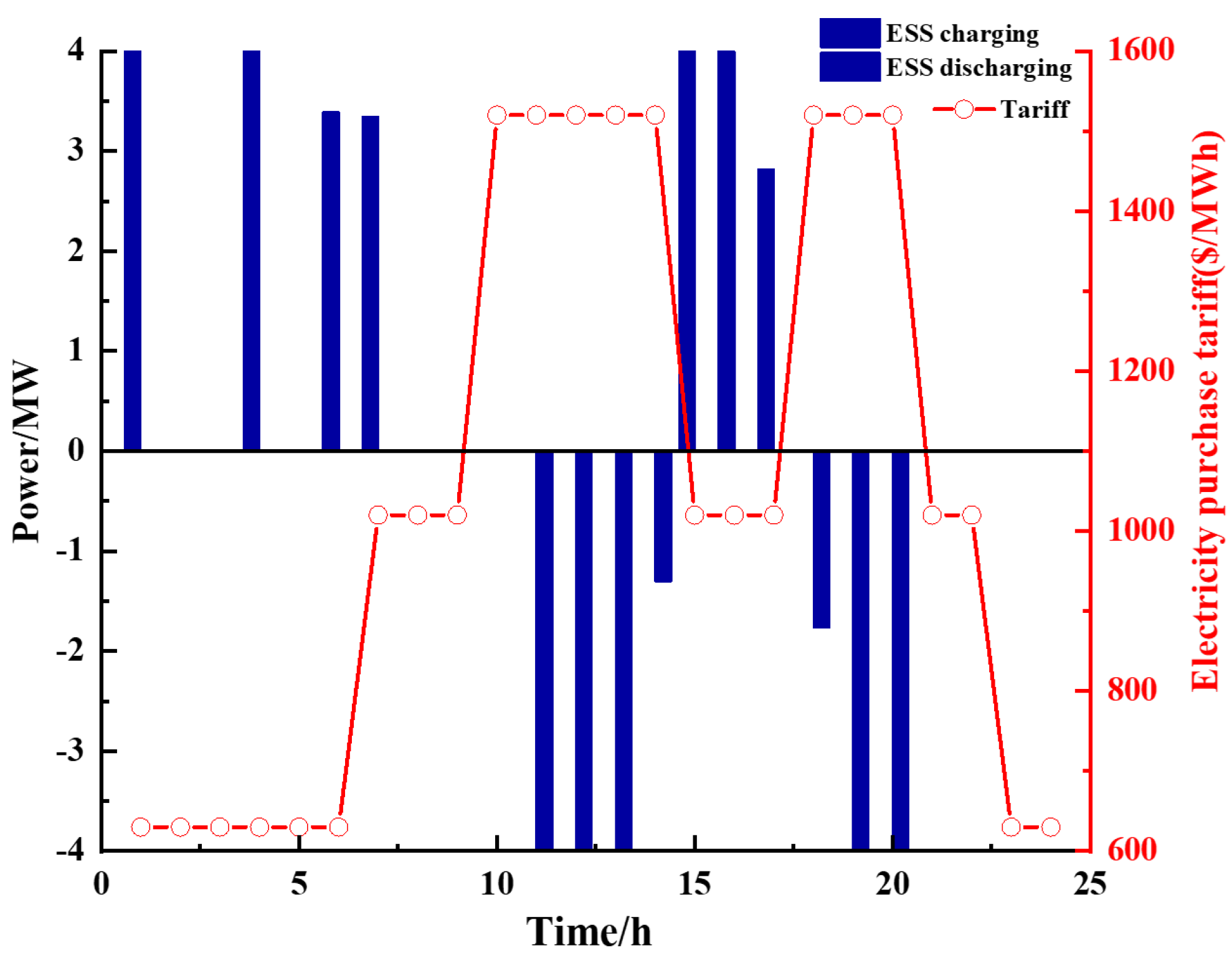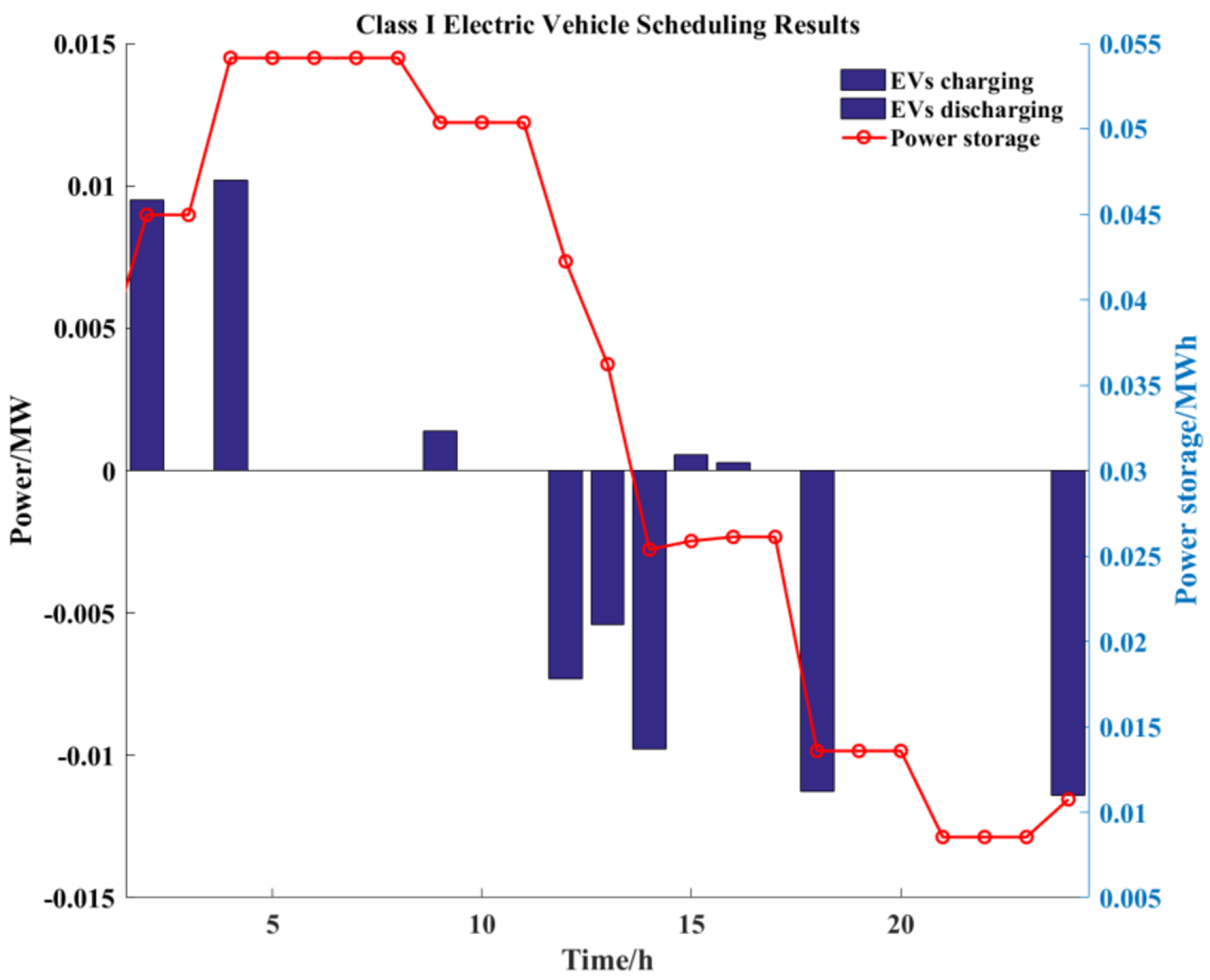Micro-Grid Day-Ahead Stochastic Optimal Dispatch Considering Multiple Demand Response and Electric Vehicles
Abstract
:1. Introduction
- 1.
- The impact of different reductions in interruptible load when considering DR in micro-grid optimization has not been analyzed.
- 2.
- DR is more divided into transferable load and interruptible load, but the air conditioning load model and its role in the optimization model are not considered.
- 3.
- EVs are only treated as an adjustable resource in micro-grid optimization, and the travel demand of electric vehicles is not analyzed in depth. Therefore, a micro-grid uncertainty day-ahead optimization model considering multiple DR and EVs is proposed in this paper.
- 1.
- The power output scenes of distributed PV in micro-grid are generated using Latin hypercube sampling by beta distribution, and the scenes are reduced using backward scene reduction method. The comparison shows that stochastic optimization is more appropriate in some cases to deal with the uncertainty of PV output.
- 2.
- An interruptible load model based on incentive-based DR is constructed, and interruptible levels are set for better participation in optimization. Meanwhile, an air conditioning load DR model is constructed and the effect of air conditioning load on optimization results under the power market is analyzed.
- 3.
- The travel demand of EVs and charging and discharging management of individual EVs are included in the optimization model. In addition, the impact of the participation of different categories of electric vehicles in the optimization is evaluated.
2. Multiple Demand Response Models
2.1. Interruptible Load Demand Response Model
2.2. Air Conditioning Load Demand Response
3. Electric Vehicles Optimization Model
4. Micro-Grid Stochastic Optimization Model
4.1. Photovoltaic Power Output Uncertainty Model
4.2. Objective Function
4.3. Related Constraints
5. Simulation Analysis
6. Conclusions
- 1.
- Stochastic optimization deals with the uncertainty of PV output and the use of backward scene reduction method, which can effectively reduce the operating costs of micro-grid. The uncertainty of PV output is handled more realistically using stochastic optimization.
- 2.
- Considering interruptible loads, air conditioning units and EVs in the micro-grid optimization behavior can achieve the reduction of micro-grid operation costs. Moreover, considering EVs alone is more beneficial to reduce micro-grid operating costs than considering DR alone.
- 3.
- EV participation in the optimization needs to focus on the analysis of the travel pattern of EVs, so as to better achieve the aggregation and optimization of EVs.
Author Contributions
Funding
Conflicts of Interest
References
- Jayalakshmi, N.; Jadoun, V.K.; Gaonkar, D.; Shrivastava, A.; Kanwar, N.; Nandini, K. Optimal operation of multi-source electric vehicle connected microgrid using metaheuristic algorithm. J. Energy Storage 2022, 52, 105067. [Google Scholar]
- Srilakshmi, E.; Singh, S.P. Energy regulation of EV using MILP for optimal operation of incentive based prosumer microgrid with uncertainty modelling. Int. J. Electr. Power Energy Syst. 2022, 134, 107353. [Google Scholar] [CrossRef]
- Wang, B.; Zhang, C.; Dong, Z.Y. Interval optimization based coordination of demand response and battery energy storage system considering SoC management in a microgrid. IEEE Trans. Sustain. Energy 2020, 11, 2922–2931. [Google Scholar] [CrossRef]
- Erenoğlu, A.K.; Şengör, İ.; Erdinç, O.; Taşcıkaraoğlu, A.; Catalão, J.P. Optimal energy management system for microgrids considering energy storage, demand response and renewable power generation. Int. J. Electr. Power Energy Syst. 2022, 136, 107714. [Google Scholar] [CrossRef]
- Sheidaei, F.; Ahmarinejad, A. Multi-stage stochastic framework for energy management of virtual power plants considering electric vehicles and demand response programs. Int. J. Electr. Power Energy Syst. 2020, 120, 106047. [Google Scholar] [CrossRef]
- Qiu, Y.; Li, Q.; Huang, L.; Sun, C.; Wang, T.; Chen, W. Adaptive uncertainty sets-based two-stage robust optimisation for economic dispatch of microgrid with demand response. IET Renew. Power Gener. 2020, 14, 3608–3615. [Google Scholar] [CrossRef]
- Zhao, H.; Lu, H.; Li, B.; Wang, X.; Zhang, S.; Wang, Y. Stochastic optimization of microgrid participating day-ahead market operation strategy with consideration of energy storage system and demand response. Energies 2020, 13, 1255. [Google Scholar] [CrossRef] [Green Version]
- MansourLakouraj, M.; Shahabi, M.; Shafie-khah, M.; Catalão, J.P. Optimal market-based operation of microgrid with the integration of wind turbines, energy storage system and demand response resources. Energy 2022, 239, 122156. [Google Scholar] [CrossRef]
- Rajamand, S. Effect of demand response program of loads in cost optimization of microgrid considering uncertain parameters in PV/WT, market price and load demand. Energy 2020, 194, 116917. [Google Scholar] [CrossRef]
- Karimi, H.; Jadid, S. Optimal energy management for multi-microgrid considering demand response programs: A stochastic multi-objective framework. Energy 2020, 195, 116992. [Google Scholar] [CrossRef]
- Gomes, I.; Melicio, R.; Mendes, V. A novel microgrid support management system based on stochastic mixed-integer linear programming. Energy 2021, 223, 120030. [Google Scholar] [CrossRef]
- Das, R.; Wang, Y.; Putrus, G.; Kotter, R.; Marzband, M.; Herteleer, B.; Warmerdam, J. Multi-objective techno-economic-environmental optimisation of electric vehicle for energy services. Appl. Energy 2020, 257, 113965. [Google Scholar] [CrossRef]
- Rezaeimozafar, M.; Eskandari, M.; Amini, M.H.; Moradi, M.H.; Siano, P. A bi-layer multi-objective techno-economical optimization model for optimal integration of distributed energy resources into smart/micro grids. Energies 2020, 13, 1706. [Google Scholar] [CrossRef] [Green Version]
- Hou, H.; Xue, M.; Xu, Y.; Xiao, Z.; Deng, X.; Xu, T.; Liu, P.; Cui, R. Multi-objective economic dispatch of a microgrid considering electric vehicle and transferable load. Appl. Energy 2020, 262, 114489. [Google Scholar] [CrossRef]
- Li, Y.; Li, K. Incorporating demand response of electric vehicles in scheduling of isolated microgrids with renewables using a bi-level programming approach. IEEE Access 2019, 7, 116256–116266. [Google Scholar] [CrossRef]
- Garcia-Guarin, J.; Alvarez, D.; Bretas, A.; Rivera, S. Schedule optimization in a smart microgrid considering demand response constraints. Energies 2020, 13, 4567. [Google Scholar] [CrossRef]
- Pandžić, H.; Kuzle, I.; Capuder, T. Virtual power plant mid-term dispatch optimization. Appl. Energy 2013, 101, 134–141. [Google Scholar] [CrossRef]
- Mesarić, P.; Krajcar, S. Home demand side management integrated with electric vehicles and renewable energy sources. Energy Build. 2015, 108, 1–9. [Google Scholar] [CrossRef]
- Wang, K.; Zhu, Z.; Guo, Z. Optimal Day-Ahead Decision-Making Scheduling of Multiple Interruptible Load Schemes for Retailer With Price Uncertainties. IEEE Access 2021, 9, 102251–102263. [Google Scholar] [CrossRef]
- Sun, G.; Qian, W.; Huang, W.; Xu, Z.; Fu, Z.; Wei, Z.; Chen, S. Stochastic adaptive robust dispatch for virtual power plants using the binding scenario identification approach. Energies 2019, 12, 1918. [Google Scholar] [CrossRef] [Green Version]
- Gurubalan, A.; Simonson, C.J. A comprehensive review of dehumidifiers and regenerators for liquid desiccant air conditioning system. Energy Convers. Manag. 2021, 240, 114234. [Google Scholar] [CrossRef]
- Ma, Y.; Xu, W.; Yang, H.; Zhang, D. Two-stage stochastic robust optimization model of microgrid day-ahead dispatching considering controllable air conditioning load. Int. J. Electr. Power Energy Syst. 2022, 141, 108174. [Google Scholar] [CrossRef]
- Ono, H.; Ohtani, Y.; Matsuo, M.; Yamaguchi, T.; Yokoyama, R. Optimal operation of heat source and air conditioning system with thermal storage tank using nonlinear programming. Energy 2021, 222, 119936. [Google Scholar] [CrossRef]
- ur Rehman, U.; Riaz, M.; Wani, M.Y. A robust optimization method for optimizing day-ahead operation of the electric vehicles aggregator. Int. J. Electr. Power Energy Syst. 2021, 132, 107179. [Google Scholar] [CrossRef]
- Yang, Z.; Li, Q.; Yan, Y.; Shang, W.L.; Ochieng, W. Examining influence factors of Chinese electric vehicle market demand based on online reviews under moderating effect of subsidy policy. Appl. Energy 2022, 326, 120019. [Google Scholar] [CrossRef]
- Ju, L.; Tan, Z.; Yuan, J.; Tan, Q.; Li, H.; Dong, F. A bi-level stochastic scheduling optimization model for a virtual power plant connected to a wind–photovoltaic–energy storage system considering the uncertainty and demand response. Appl. Energy 2016, 171, 184–199. [Google Scholar] [CrossRef] [Green Version]
- Chen, Z.; Wu, L.; Fu, Y. Real-time price-based demand response management for residential appliances via stochastic optimization and robust optimization. IEEE Trans. Smart Grid 2012, 3, 1822–1831. [Google Scholar] [CrossRef]
- Zeng, L.; Xu, J.; Wang, Y.; Liu, Y.; Tang, J.; Jiang, Z.; Wen, M. Day-ahead interval optimization of combined cooling and power microgrid based on interval measurement. Energy Build. 2022, 273, 112383. [Google Scholar] [CrossRef]
- Zeng, L.; Xu, J.; Wu, M.; Tang, J.; Wu, Q.; Wang, Q.; Fan, G. Day-ahead interval optimization for CCHP system considering uncertainty of wind power and PV. Int. J. Electr. Power Energy Syst. 2022, 138, 107895. [Google Scholar] [CrossRef]
- Liu, G.; Tao, Y.; Xu, L.; Chen, Z.; Qiu, J.; Lai, S. Coordinated management of aggregated electric vehicles and thermostatically controlled loads in hierarchical energy systems. Int. J. Electr. Power Energy Syst. 2021, 131, 107090. [Google Scholar] [CrossRef]
- Hosseini, S.M.; Carli, R.; Dotoli, M. A residential demand-side management strategy under nonlinear pricing based on robust model predictive control. In Proceedings of the 2019 IEEE International Conference on Systems, Man and Cybernetics (SMC), Bari, Italy, 6–9 October 2019; pp. 3243–3248. [Google Scholar]









| Scenes | PV Uncertainty | DR | EVs |
|---|---|---|---|
| 1 | ✗ | ✓ | ✓ |
| 2 | ✗ | ✓ | ✗ |
| 3 | ✗ | ✗ | ✓ |
| 4 | ✓ | ✓ | ✓ |
| Type | Battery Capacity /(kWh) | Energy Requirement /(kW/mile) | Battery Cost/$ | Time of Travel/h | The Driving Distance Corresponding to Each Travel Period/(mile) |
|---|---|---|---|---|---|
| First | 57 | 0.229 | 22,800 | 8,17 | 22,22 |
| Second | 24 | 0.228 | 9600 | 9,21 | 11,11 |
| Pollution Gas | NOx | CO2 | CO | SO2 |
|---|---|---|---|---|
| Emission load/(kg/MWh) | 0.6188 | 184.083 | 0.1702 | 0.00093 |
| Environmental value/($/kg) | 1 | 0.00288 | 0.125 | 0.75 |
| Penalty coefficient/($/kg) | 0.25 | 0.00125 | 0.02 | 0.125 |
| Scenes | Total Objective Function/$ | The Costs of DR/USD | The Costs of EVs/USD | Remaining Costs/USD |
|---|---|---|---|---|
| 1 | 5747.98 | 13,799 | 211.079 | −8262.13 |
| 2 | 25,391.6 | 13,800.8 | / | 11,590.8 |
| 3 | 9579.23 | / | 206.551 | 9372.68 |
| 4 | 5659.03 | 13,660.9 | 210.036 | −8211.91 |
| 5 | 5695.5892 | 13,697.4327 | 209.0186 | −8210.8621 |
Disclaimer/Publisher’s Note: The statements, opinions and data contained in all publications are solely those of the individual author(s) and contributor(s) and not of MDPI and/or the editor(s). MDPI and/or the editor(s) disclaim responsibility for any injury to people or property resulting from any ideas, methods, instructions or products referred to in the content. |
© 2023 by the authors. Licensee MDPI, Basel, Switzerland. This article is an open access article distributed under the terms and conditions of the Creative Commons Attribution (CC BY) license (https://creativecommons.org/licenses/by/4.0/).
Share and Cite
Li, J.; Yang, M.; Zhang, Y.; Li, J.; Lu, J. Micro-Grid Day-Ahead Stochastic Optimal Dispatch Considering Multiple Demand Response and Electric Vehicles. Energies 2023, 16, 3356. https://doi.org/10.3390/en16083356
Li J, Yang M, Zhang Y, Li J, Lu J. Micro-Grid Day-Ahead Stochastic Optimal Dispatch Considering Multiple Demand Response and Electric Vehicles. Energies. 2023; 16(8):3356. https://doi.org/10.3390/en16083356
Chicago/Turabian StyleLi, Jianying, Minsheng Yang, Yuexing Zhang, Jianqi Li, and Jianquan Lu. 2023. "Micro-Grid Day-Ahead Stochastic Optimal Dispatch Considering Multiple Demand Response and Electric Vehicles" Energies 16, no. 8: 3356. https://doi.org/10.3390/en16083356





